就地有多个定义。一个严格的定义是。
An in-place algorithm is an algorithm that does not need an extra space and produces an output in the same memory that contains the data by transforming the input ‘in-place’. However, a small constant extra space used for variables is allowed.
更广义的定义是
In-place means that the algorithm does not use extra space for manipulating the input but may require a small though nonconstant extra space for its operation. Usually, this space is O(log n), though sometimes anything in o(n) (Smaller than linear) is allowed [Source : Wikipedia]
反转数组的非就地实现
C++
// An Not in-place C++ program to reverse an array
#include
using namespace std;
/* Function to reverse arr[] from start to end*/
void revereseArray(int arr[], int n)
{
// Create a copy array and store reversed
// elements
int rev[n];
for (int i=0; i Java
// An Not in-place Java program
// to reverse an array
import java.util.*;
class GFG
{
/* Function to reverse arr[]
from start to end*/
public static void revereseArray(int []arr,
int n)
{
// Create a copy array
// and store reversed
// elements
int []rev = new int[n];
for (int i = 0; i < n; i++)
rev[n - i - 1] = arr[i];
// Now copy reversed
// elements back to arr[]
for (int i = 0; i < n; i++)
arr[i] = rev[i];
}
/* Utility function to
print an array */
public static void printArray(int []arr,
int size)
{
for (int i = 0; i < size; i++)
System.out.print(arr[i] + " ");
System.out.println("");
}
// Driver code
public static void main(String[] args)
{
int arr[] = {1, 2, 3, 4, 5, 6};
int n = arr.length;
printArray(arr, n);
revereseArray(arr, n);
System.out.println("Reversed array is");
printArray(arr, n);
}
}
// This code is contributed
// by Harshit SainiPython3
# An Not in-place Python program
# to reverse an array
''' Function to reverse arr[]
from start to end '''
def revereseArray(arr, n):
# Create a copy array
# and store reversed
# elements
rev = n * [0]
for i in range(0, n):
rev[n - i - 1] = arr[i]
# Now copy reversed
# elements back to arr[]
for i in range(0, n):
arr[i] = rev[i]
# Driver code
if __name__ == "__main__":
arr = [1, 2, 3, 4, 5, 6]
n = len(arr)
print(*arr)
revereseArray(arr, n);
print("Reversed array is")
print(*arr)
# This code is contributed
# by Harshit SainiC#
// An Not in-place C# program
// to reverse an array
using System;
class GFG
{
/* Function to reverse arr[]
from start to end*/
public static void revereseArray(int[] arr,
int n)
{
// Create a copy array
// and store reversed
// elements
int[] rev = new int[n];
for (int i = 0; i < n; i++)
rev[n - i - 1] = arr[i];
// Now copy reversed
// elements back to arr[]
for (int i = 0; i < n; i++)
arr[i] = rev[i];
}
/* Utility function to
print an array */
public static void printArray(int[] arr,
int size)
{
for (int i = 0; i < size; i++)
Console.Write(arr[i] + " ");
Console.Write("\n");
}
// Driver code
public static void Main()
{
int[] arr = {1, 2, 3, 4, 5, 6};
int n = arr.Length;
printArray(arr, n);
revereseArray(arr, n);
Console.WriteLine("Reversed array is");
printArray(arr, n);
}
}
// This code is contributed by Ita_c.C++
// An in-place C++ program to reverse an array
#include
using namespace std;
/* Function to reverse arr[] from start to end*/
void revereseArray(int arr[], int n)
{
for (int i=0; i Java
// An in-place Java program
// to reverse an array
import java.util.*;
class GFG
{
public static int __(int x, int y) {return x;}
/* Function to reverse arr[]
from start to end*/
public static void revereseArray(int []arr,
int n)
{
for (int i = 0; i < n / 2; i++)
arr[i] = __(arr[n - i - 1],
arr[n - i - 1] = arr[i]);
}
/* Utility function to
print an array */
public static void printArray(int []arr,
int size)
{
for (int i = 0; i < size; i++)
System.out.print(Integer.toString(arr[i]) + " ");
System.out.println("");
}
// Driver code
public static void main(String[] args)
{
int []arr = new int[]{1, 2, 3, 4, 5, 6};
int n = arr.length;
printArray(arr, n);
revereseArray(arr, n);
System.out.println("Reversed array is");
printArray(arr, n);
}
}
// This code is contributed
// by Harshit SainiPython3
# An in-place Python program
# to reverse an array
''' Function to reverse arr[]
from start to end'''
def revereseArray(arr, n):
for i in range(0, int(n / 2)):
arr[i], arr[n - i - 1] = arr[n - i - 1], arr[i]
# Driver code
if __name__ == "__main__":
arr = [1, 2, 3, 4, 5, 6]
n = len(arr)
print(*arr)
revereseArray(arr, n)
print("Reversed array is")
print(*arr)
# This code is contributed
# by Harshit SainiC#
// An in-place C# program
// to reverse an array
using System;
class GFG
{
public static int __(int x, int y) {return x;}
/* Function to reverse arr[]
from start to end*/
public static void revereseArray(int []arr,
int n)
{
for (int i = 0; i < n / 2; i++)
arr[i] = __(arr[n - i - 1],
arr[n - i - 1] = arr[i]);
}
/* Utility function to
print an array */
public static void printArray(int []arr,
int size)
{
for (int i = 0; i < size; i++)
Console.Write(arr[i] + " ");
Console.WriteLine("");
}
// Driver code
public static void Main(String[] args)
{
int []arr = new int[]{1, 2, 3, 4, 5, 6};
int n = arr.Length;
printArray(arr, n);
revereseArray(arr, n);
Console.WriteLine("Reversed array is");
printArray(arr, n);
}
}
/* This code is contributed by PrinciRaj1992 */1 2 3 4 5 6
Reversed array is
6 5 4 3 2 1
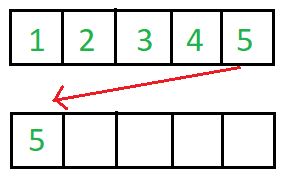
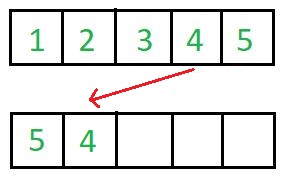
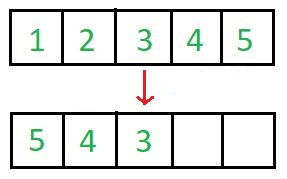

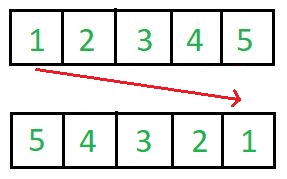
这需要O(n)额外空间,并且是非就地算法的一个示例。
反转数组的就地实现。
C++
// An in-place C++ program to reverse an array
#include
using namespace std;
/* Function to reverse arr[] from start to end*/
void revereseArray(int arr[], int n)
{
for (int i=0; i Java
// An in-place Java program
// to reverse an array
import java.util.*;
class GFG
{
public static int __(int x, int y) {return x;}
/* Function to reverse arr[]
from start to end*/
public static void revereseArray(int []arr,
int n)
{
for (int i = 0; i < n / 2; i++)
arr[i] = __(arr[n - i - 1],
arr[n - i - 1] = arr[i]);
}
/* Utility function to
print an array */
public static void printArray(int []arr,
int size)
{
for (int i = 0; i < size; i++)
System.out.print(Integer.toString(arr[i]) + " ");
System.out.println("");
}
// Driver code
public static void main(String[] args)
{
int []arr = new int[]{1, 2, 3, 4, 5, 6};
int n = arr.length;
printArray(arr, n);
revereseArray(arr, n);
System.out.println("Reversed array is");
printArray(arr, n);
}
}
// This code is contributed
// by Harshit Saini
Python3
# An in-place Python program
# to reverse an array
''' Function to reverse arr[]
from start to end'''
def revereseArray(arr, n):
for i in range(0, int(n / 2)):
arr[i], arr[n - i - 1] = arr[n - i - 1], arr[i]
# Driver code
if __name__ == "__main__":
arr = [1, 2, 3, 4, 5, 6]
n = len(arr)
print(*arr)
revereseArray(arr, n)
print("Reversed array is")
print(*arr)
# This code is contributed
# by Harshit Saini
C#
// An in-place C# program
// to reverse an array
using System;
class GFG
{
public static int __(int x, int y) {return x;}
/* Function to reverse arr[]
from start to end*/
public static void revereseArray(int []arr,
int n)
{
for (int i = 0; i < n / 2; i++)
arr[i] = __(arr[n - i - 1],
arr[n - i - 1] = arr[i]);
}
/* Utility function to
print an array */
public static void printArray(int []arr,
int size)
{
for (int i = 0; i < size; i++)
Console.Write(arr[i] + " ");
Console.WriteLine("");
}
// Driver code
public static void Main(String[] args)
{
int []arr = new int[]{1, 2, 3, 4, 5, 6};
int n = arr.Length;
printArray(arr, n);
revereseArray(arr, n);
Console.WriteLine("Reversed array is");
printArray(arr, n);
}
}
/* This code is contributed by PrinciRaj1992 */
1 2 3 4 5 6
Reversed array is
6 5 4 3 2 1
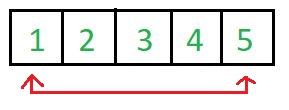
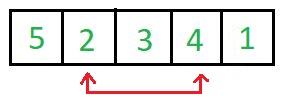
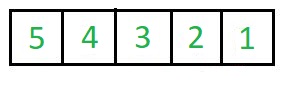
这需要O(1)额外的空间来交换元素,这是就地算法的一个示例。
哪些排序算法是就地的,哪些不是?
到位:气泡排序,选择排序,插入排序,堆排序。
不到位:合并排序。请注意,合并排序需要O(n)额外的空间。
那QuickSort呢?为什么称为就地?
QuickSort使用额外的空间进行递归函数调用。根据广泛的定义,它被称为就地,因为所需的额外空间不用于操作输入,而仅用于递归调用。